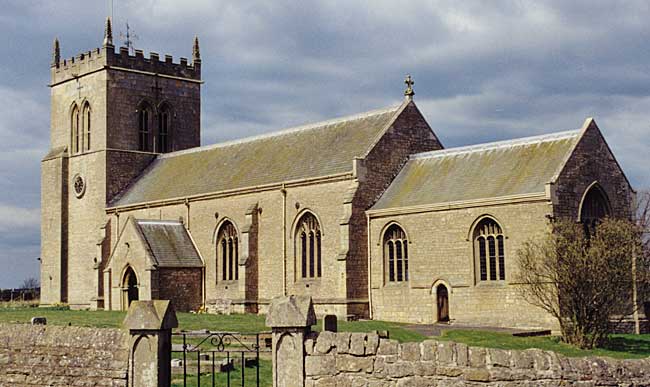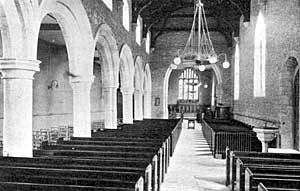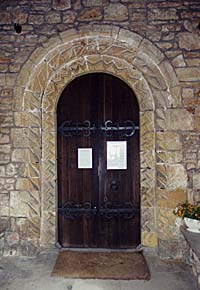Norton Cuckney church
By The Rev J W Smith

St Mary's church, Cuckney (photo: A Nicholson, 2002).
At the Conquest (1066) the chief part of the parish was held by Hugh Fitz Baldric, and then had a church and priest.
1066. Joce de Flemangh, who came with the Conqueror, became possessed of land in Cuckney.
Then there lived at Cuckney an old knight–named Gamelbere–who lived there before the Conquest, and held two carucates of land on condition of shoeing the king’s palfry whenever he came to his manor of Mansfield (i.e., Clipstone). Gamelbere died without heirs in the reign of Henry I., who gave the land to Richard, son of Joce de Flemangh (named above) for the same service (shoeing, etc.).
This Richard had a son called Thomas de Cuckeney, who built a castle (now the Castle Hill in the churchyard), and in Henry II.’s reign founded Welbeck Abbey.
By marriage the lands of de Flemangh passed to the family of Fauconberg. Sir Henry de Fauconberg, by will, dated September, 1329, gave them to John de Hotham, Bishop of Ely, and the Bishop of Ely conveyed all to the Abbot and Convent at Welbeck, December 4th, 1329.
So far as can be learnt from the existing remains, there was a church here in Norman times, and the 12th century doorway between the porch and the nave, the western half-pier and one column of the arcade between the nave and the north aisle, and a piscina in the nave are still left in almost as good a condition as when they were built. The church appears to have been re-built in the 13th century, and the remains of this work are the tower (up to the belfry stage),the porch, the walls of the chancel and two of the piers, with clustered columns of the arcade between the nave and north aisle. The 13th century building was remarkable for its great length, the extreme length from east to west externally is 145ft.: the chancel being 33ft. long internally, the nave 79ft., and the tower l8ft. The nave was evidently again re-built in the 15th century, and the south wall with its three Perpendicular windows remains as then erected. The chancel arch and tower arch are also of this date, and probably the jambs of the wider east window, and one window in the south side of the chancel, now half buried in the walls, but visible outside and inside, though it is possible that these may be the jambs of the original 13th century windows. The two octagonal piers of the nave arcade and the half pier at the east end are also of the 15th century. The nave arcade seems to have been re-built in the time of Elizabeth with semi-circular arches, the double-splayed mouldings being probably similar to those of the 15th century arcade, and a row of square-headed clerestory windows above. This arcade leans 6in. outwards.

Interior of St Mary's church, Cuckney in 1914.
The north aisle appears to have been re-built at the same time, four of the windows being similar, but this wall was apparently built on insecure foundations, and tilts about 8in. outwards from the ground level to just below the eaves, a height of only l0ft., not withstanding the very heavy buttresses which have prevented it from falling. The stones of these buttresses are evidently old ones re-used, one stone coffin lid of the 13th or 14th century having been cut in two and built in the sides of one of the buttresses. Other similar coffin lids were used as internal sills to the windows of this wall.
The windows of the chancel seem to have been renewed in the late 16th century, with semi-circular heads to the lights, but without the cusped tracery of the preceding period. The stonework of the east window was restored in 1892 to receive the stained glass memorial window. The walls of the vestry and organ chamber were probably built in the 16th century, and may have formed a chapel, but only one of the windows is contemporary. It was used as a school in after years. The upper part of the tower seems to date from the 16th or early 17th century, and the window in the older portion above the west door is an insertion of that period.
The church was restored (?) in 1831-2, and the roofs were entirely reconstructed of a low pitch and with flat plastered ceilings, those of the nave and north aisle being divided by wood beams longitudinally and transversely, and the inside face of the north aisle was blocked up with wood and plaster to make it appear upright. On the south side of the nave a stone cornice with a classic moulding was superimposed on the Gothic cornice, the moulded front of which was hacked off, and the whole of the external walls, except those of the chancel, were coated with rough cast, the stone being punched and hacked to form a key. The nave floor was then re-laid at the same level as the chancel, and the moulded bases of the arcade piers were partially buried. Two galleries were built in the nave, one at the east end and the other at the west end. The pulpit was placed near the south door, and the church re-seated with high pews of various shapes and sizes, the passage up the nave being considerably out of the centre. The gallery in the east end of the nave was removed in 1876 to make room for the organ.

Norman doorway to St Mary's church, Cuckney in 2002.
In 1907, thanks largely to the generosity of the Duke of Portland, the church, which badly needed it, was restored. The ground on the west and south sides was lowered to its original level, disclosing the bases and plinths of the porch and tower. The whole of the rough-cast was removed from the walls, which were repaired and pointed. A heating chamber was constructed adjoining the vestry, a new wall was built on the east side of the vestry, with a window like the existing 16th century one. Moulded stone cornices of a Gothic character were put to the nave walls, and the porch walls underpinned, the buttresses, bases, and plinths repaired and the gable raised and restored to its original pitch, as well as the gable at the east end of the nave. The walls under the tower arch, the gallery and staircase were removed. New open timbered roofs of a higher pitch were substituted for the former low-pitched roofs over the nave and porch. The floors of the nave, north aisle, and tower were lowered to what is believed to have been their original levels, about 18in. below the ground outside. Plaster was stripped from the walls of the nave and they were pointed, the old pews were removed and pitch pine seating fitted, and four steps were added to the sanctuary.
Altar, pulpit, and screen across the tower were added at the same time.
The architect was Mr. Louis Ambler, F.R.I.B.A.
There is an old Jacobean table in the vestry. An old holy water stoop has recently been recovered from a garden at Norton.
In 1914 two bells were added by the Duke of Portland, the whole hung in a new frame.
The dates and inscriptions on the bells are :—
Tenor. 1639 (re-cast 1914).
" All men that hear my mournful sound,
Repent before ye lie in ground."
5. 1626.-" God save this Church."
4. 1810.-" F. Donisthorne, Vicar, J. Presley & B. Turner, wardens, T. Hilton founder Wath."
3. 1641.-"I God save this Church."
2. 1914. |
" A. M. D.G. given by the sixth Duke of Portland K.G. 1914 to commemorate his Silver Wedding and the coming of age of his elder son The Marquis of Tichfield." |
1. 1914. |
In the churchyard, on the south side of the nave, this curious inscription appears on a tombstone:— “Sarah, the wife of George Shaw, who died the 5th, April 1797 in the 767 year of her age.”
The pewter plate, dated 1687, consists of a chalice. The registers date from 1632.
The following entries appear in the registers of Norton Cuckney Church:—
"May 17, 1751.
“We whose names are hereunder written inhabitants of the Parish of
Cuckney do agree and apoint that for the future no Churchwarden or
Clerk of the said Parish shall have any right or claim to the Bell
ropes. But that they shall continue at the Bells from year to year
as long as 8t to ring with and when new ropes are put to ye Bells,
the old ones to remain in the Church to repair those in use when wanted
and that the Clerk for repairing or mending the same shall be paid
from time to time as the Churchwardens shall so propos
| “Witness our hands | |
| "John Richardson, Vicar "John Stocks "John Rolling Churchwardens.” |
“Sep 22, 1759 Memorandum of an Agreement by all the Parishioners that
from ye date hereof there shall be no ale alowd about any work done
by ye parish nor no Foxes paid for but what is visibly brought into
the Church yard nor no ale to be alowd to any days of Rejoycing for
ye Ringers but what ye Vicar and Churchwardens is agreeable to alow "
Edward Otter, Vicar
“Etc.”
After luncheon at the Greendale Oak Inn, the party proceeded by the road alongside Carburton Lakes to Carburton, where the following notes on the church were read by Mr. Harry Gill.
